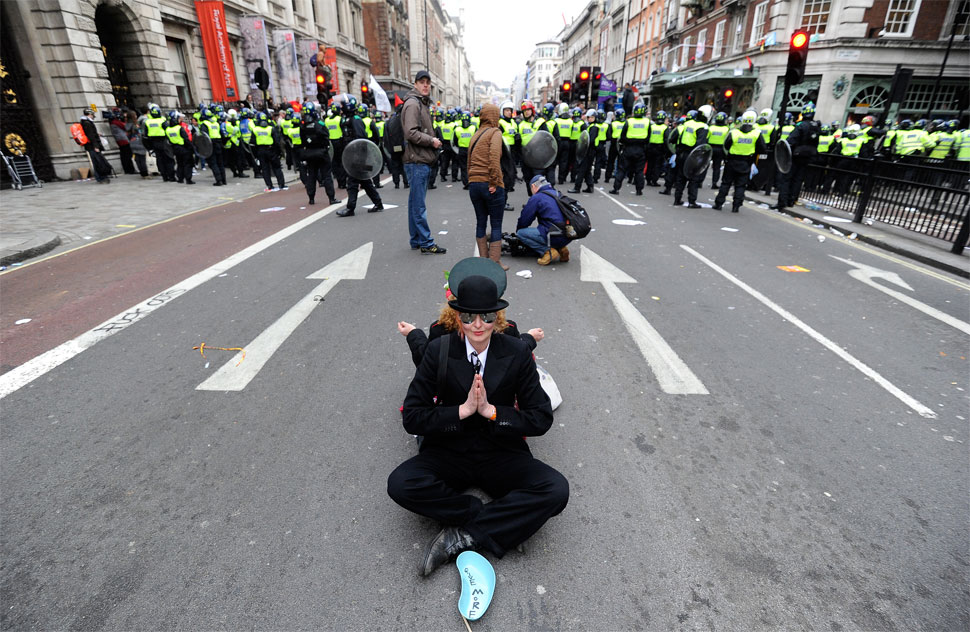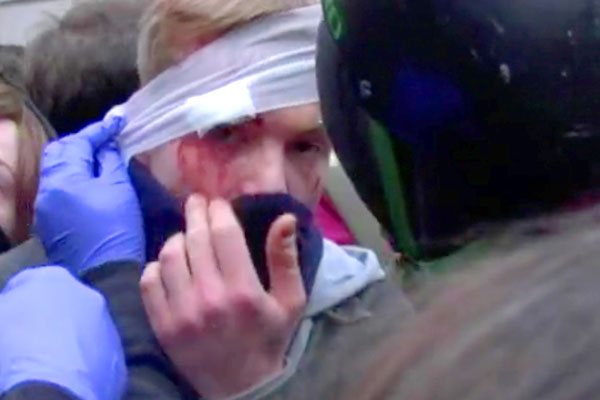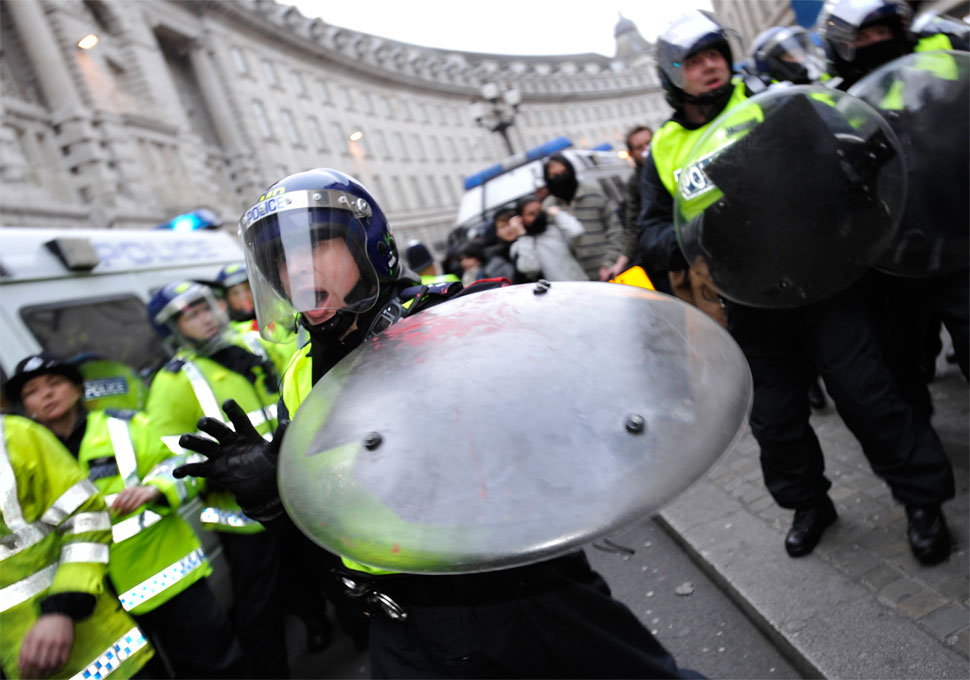Lies in London

Lies in London

Demonstrators sit down on Piccadilly during a protest organised by the Trades Union Congress, in central London. Photo: Paul Hackett / Reuters
What went wrong?
As the dust settles and the slogans are scrubbed off the walls of Fortnum and Mason, that’s the question the entire British Left is asking itself about the events of March the 26th. What went wrong? Where do we go from here? And most importantly, who do we blame?
That last part is easy: we blame it on the kids. The story currently being spun by the police, by parties in government, and by most of the press is that an otherwise successful mass demonstration was ruined by disgusting little vandals with hate in their hearts. That mindless acts of violence were perpetrated by a small, hardcore group of hooligans calling themselves ‘the black bloc’, who trashed banks and businesses at random and attacked the police without provocation. That their behaviour undermined and discredited the half-million citizens who marched to the rally point in Hyde Park. That it was a major own goal for the Left in this time of crisis.
That assessment is incorrect on nearly every level. Unfortunately, the handful of reporters, including myself, who dared to produce accounts of the day that run counter to the mainstream consensus, have been savagely attacked. We have been called thugs, liars and terrorists for having the temerity to put on record the police brutality that some of us observed and experienced in Trafalgar square. We have faced down attempts to bully and threaten us into retracting our testimonies.

Ben, 21, was struck on the head during marches in London.
I feel obligated to restate that the accepted public narrative about the events in London on March the 26th is factually incorrect on several important counts. In the first instance, there were not a ‘few hundred’ dedicated ‘criminals’ on Oxford Street and in Picadilly on Saturday, but thousands and thousands of people, mostly under thirty and unaffiliated, many of whom had come straight from flag-waving and banner-holding on the main march through Whitehall to join in with the peaceful actions planned in central London. These actions had been organised by the campaigning group UKUncut. Some of them, such as the store occupations, were potentially unlawful- but they were peaceful and politically motivated, like all of UKUncut’s previous projects.
Secondly, the ‘black bloc’ – a phrase that will undoubtedly be used to terrify wavering tabloid readers for years to come – is not an organisation, but a tactic. It is a tactic used, rightly or wrongly, to facilitate the sort of civil disobedience that becomes attractive to the young and the desperate when every polite model of political expression has let them down. Although there were a small number of genuinely violent agitators in attendance on Saturday, most of them middle aged, drunk and uninterested in the main protest, a great many of the young people who chose to mask up and wear black in order to commit acts of civil disobedience had never done anything of the kind before.
Those young people came from all over the country. They were students, schoolkids, workers and union members. Nine months ago, many of them were political interns, members of the Labour party or volunteers for the Liberal Democrats. Nine months ago, many of them still believed, however naively, that the democratic process might deliver real change. Now a new spirit of youthful unrest has been born into an ugly and uncomprehending political reality. A generation has been radicalised by the betrayal of their modest request for a fair future, and by repeated experiences of police brutality against those who chose to resist.
Those young people, with their energy and their idealism, briefly looked set to capture the hearts and minds of the nation. Following the events of march the 26th, former sympathisers in the Labour movement and on the liberal left are now falling over themselves to disown Britain’s disaffected youth.
Facing lazy calls to ‘condemn the violence’ or be held complicit in the media backlash, most of the centre-left has condemned, and condemned, and condemned. They have paused only to blame one another for ever entertaining these ‘kids’ and their politics. They have dismissed the angry young people of this country without actually asking themselves how it came to this.
That dismissal cannot be allowed to continue without serious unpacking. Ultimately, it is not these young people who have let down the Labour movement – it is the Labour movement and the Labour party in particular that has let down the young, the poor and the desperate, not once but repeatedly, failing to stand behind their demands for change, failing to offer any alternative to the cuts other than its own re-election on a platform of slightly mitigated austerity. We should not be surprised that so many thousands couldn’t be bothered to listen to Ed Miliband speak, and went to Oxford Street instead to do some direct action.

An injury suffered by Ben, 21, is treated by a medic during marches in London.
Then there’s the third misconception. The ‘violence’ enacted upon the defenceless shopfronts of major financial fiefdoms may have looked terrifying and uncontrolled on camera, but it was far from mindless. These targets were not chosen at random. British banks and major tax-avoiding companies were attacked because these companies are seen by large swathes of the public as being responsible for the banking crisis and for subsequent ideological decisions on the part of the current government to mortgage healthcare, welfare and education. In the rush, Spanish banking giant Santander was also vandalised – and we need to be asking ourselves just what has made our nation’s children so very upset with world finance that they believe any bank is fair game.
Nobody’s children are at risk from this sort of political ‘violence’. Many children were, in fact, part of the protest, singing and dancing on Oxford street or carried on the shoulders of their parents to watch UKUncut’s comedy gig in Soho square. There are serious problems with the way in which the press chooses to discuss ‘violence’ in relation to the protests, and chief amongst those problems is the way in which the violence done to private property is now considered morally equivalent to physical violence against human beings.
It’s the second sort of violence that really does put people’s children at risk, and it’s that sort of violence that I saw dispensed without mercy by police on the bodies of Saturday’s young protesters, the vast majority of whom were engaged in peaceful civil disobedience, almost a hundred of whom were hospitalised for their trouble, with broken limbs and streaming head-wounds.
“The police tried to kettle us outside Fortnum and Mason, and fearing for the safety of the crowd in case of a crush, some of us formed a line in front of the police,” says Ben, 21, whose face is swollen and covered bloody cuts. “This was passive resistance. Our arms were interlocked and we were clearly no threat to the police. Without provocation, an officer punched me six times in the face, hit me three times on the head with the edge of a riot shield, kicked me ten times in the shins and three times in the groin.
“I could not move or defend myself, so I bent my head to shield myself from his blows; it was only when I saw the blood running down my tshirt that I realised how badly I’d been hurt.
”
‘They were kicking people on the ground and dragging them away to be arrested. That was after blocking us inside the store ‘for our own safety’ and promising we would be allowed to leave peacefully,” says one member of UKUncut who was involved in the quiet sit-in inside Fortnum and Mason. “We were handcuffed and taken to cells across London, made to strip to our underwear and given white paper jumpsuits to wear.
“I was left for eighteen hours without food and woken up repeatedly, once for DNA swabs and fingerprints. It felt like they were trying to scare me away from peaceful protest, treating me like a faceless terrorist when I’m just an ordinary citizen standing up for what I believe in.”
Commentators are not wrong in calling march the 26th a loss for the Left. It is unfair, however, to blame that loss on the thousands of young people who chose to demonstrate outside the approved march route- although undoubtedly mistakes were made by organising parties in picking targets and anticipating the size and energy of attendance. The implication that the day would have been a success had everyone just played by the rules is a vastly disingenuous statement unworthy of the many respected liberal commentators who have made it.
After the event, Vince Cable released a statement to the effect that the March for the Alternative is to have no impact whatsoever on the speed and savagery of public spending cuts. The speed with which the statement was released strongly implies that it had been written before the first protestor had got on the coach. What ‘ruined the day’ was not young people committing acts of civil disobedience and spoiling it for everyone else. What ‘ruined the day’, if the day really was ruined, was the state’s determination to ignore the weight of public opposition to its savage programme of spending cuts.
This is not to imply that the march was a waste of time, nor that those who marched were wrong to do so. Not everyone feels able to risk their job in order to occupy a bank. What the march and its aftermath reveal, however, is that the model of opposition and public mobilisation offered by the unions and the Labour party is totally inadequate to the task at hand, and alienating for a great deal of workers and families , as well as the many thousands of people who are already too desperate to protest quietly and obediently.
Marching from A to B to voice vague objections to government spending plans, marching behind Labour and union leaders who fail entirely to offer a coherent alternative, is no longer a sufficient response to these cuts. It is not sufficient because this government, like the previous government, is not at all worried by the prospect of hundreds of thousands of people marching from A to B. They are worried about the prospect of a truly popular people’s uprising. They are worried about losing the ideological argument over the necessity of destroying the welfare state. They are worried by the prospect of a run on the banks engineered by digital people power, as just occurred in Holland, and they are worried about the prospect of a general strike. It’s safe to say that the government has a lot less to worry about this week than it did last week- and activists, anarchists, unions and the Labour movement all need to be asking ourselves why.

Police confront demonstrators at a march near Picadilly Circus in London.
This government isn’t scared of mass vandalism. The public, however, is – and that is precisely why fistfuls of images of young people in masks smashing up the Ritz and throwing smoke bombs have been tossed at our screens for five days now. The state requires us to be fearful so that it can acquire our consent for its spending cuts, and the public fears disorder even more than it fears mass unemployment and the decimaton of public services. So perhaps we shouldn’t be surprised that the images of officers of the law assaulting unarmed young people, and the images of riot cops arresting an entirely peaceful protest group on orders which are rumoured to have come right from the top, have largely been been overlooked or dismissed.
Meanwhile, UKUncut – a group whose modus operandi is inclusive, creative, defiant people power of the type that really does scare the government – has been brutally suppressed. A hundred and thirty eight members have been detained, including a fifteen year old girl who was so frightened in jail that she was made to sign a form excusing the police from culpability, should she go on to commit suicide. There has been very little public outcry. The next wave in the battle for the hearts and minds of the British public has truly begun.
This is the follow-up to an earlier article published at the New Statesman.